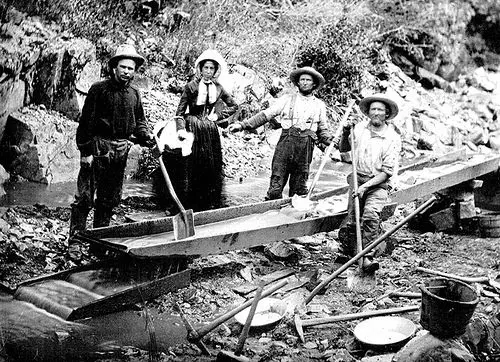Gold
California Gold Rush

Major gold rushes took place around the globe in the 18th century, particularly in the United States during the period between 1850 and 1880. While mining gold itself proved unprofitable for mine-owners and diggers, some individuals made significant fortunes in this era while transportation facilities and merchants earned large profits.
Gold Rush Facts for Kids
- Miners discovered over 700,000 pounds of gold in the California Gold Rush.
- From 1848 to 1849, the Californian population grew by over 100,000.
- White miners subjected Latin American and Chinese immigrants to violent and racial attacks
- Samuel Brannan was the wealthiest man during the California Gold Rush. He was a shopkeeper who also worked as a promoter and a newspaper publisher.
- The lack of law enforcement, sanitation, and housing in the mining camps and its surrounding parts resulted in higher crime rates.
- Many immigrants did not make it to California in the Gold Rush. Most of them died because of fever, cholera, accidents, and a myriad of other causes.
- By 1850, the non-native population of California grew to 100,000, which was 80,000 more than in 1848.
- Gold mining towns all over the region opened brothels, saloons, and shops to accommodate the needs of the 49ers.
- Scholars revealed that merchants made more money than diggers during the California Gold Rush.
More often than not, gold rushes were usually marked by a general floating emotion of a free-for-all in profit mobility wherein everyone can become wealthy instantly. These gold rushes generated waves of immigrants, which typically led to a permanent settlement of new regions. In most cases, the activities propelled by gold rushes characterize massive aspects of the North American frontiers.
Perhaps one of the most popular gold rushes during this period was The California Gold Rush, which initially started on January 24, 1848, and flourished until 1855. The California Gold Rush was mainly attributed to the discovery of gold by James W. Marshall in Sutter’s Mill along the mountains of Coloma in California.
The 49ers
Interestingly, the news of gold led to approximately 300,000 individuals, also known as the forty-niners (49ers), moving to California from abroad and the rest of the United States. The immediate influx of gold into the money supply spurred the American economy, which also resulted in the sudden population increase that enabled California to become a state.
According to historians, a total of $2 billion worth of precious metal was discovered during the peak of the Gold Rush. Prospectors came not only from Southern and Eastern United States but from Australia, Europe, Latin America, and Asia.
Significant improvements in railroad and steamship technology facilitated this move, which dramatically changed the demographics of the state of California. Gold rushes in America also saw substantial effects, especially for indigenous societies who were attacked and forced to leave their lands by the 49ers.
Did immigrants find wealth?
While gold-tined visions of luxury and natural wealth motivated migration, the lives of a 49er were brutal. Though a few immigrants became wealthy, panning for gold rarely resulted in anything of actual value, and the job itself was time-consuming and injury-ridden.
After 1855, the surface gold in California was significantly gone despite the continued arrival of mining. As gold becomes increasingly more difficult to mine, the rising industrialization of mining drove more miners from the idea of living in luxury into wage labor. While new techniques like hydraulic mining were developed, it destroyed much of the landscape of the region.
What is more, is that gold mining became more complex as panning could only turn up whatever gold stored in silt deposits. Individual diggers eventually could not keep up with the technological sophistication and the kinds of resources of the top mining companies, which resulted in them ultimately giving up and turning to the logging industry.
Who was the richest man in California during the Gold Rush?
Samuel Brannan was the richest man in California during the Gold Rush.
What was the non-native population of California in 1850?
The non-native population of California in 1850 was 100,000.
When did the California Gold Rush start?
The California Gold Rush started on January 24, 1848.
Why did many immigrants fail to reach America during the Gold Rush?
Many immigrants were unable to reach America during the Gold Rush because of cholera, fever, and accidents.
How many pounds of gold did the miners extract in the Gold Rush?
Miners extracted more than 700,000 pounds of gold during this period.



